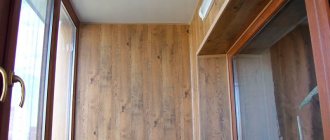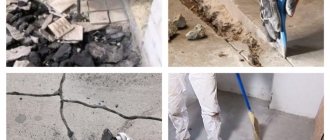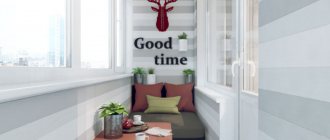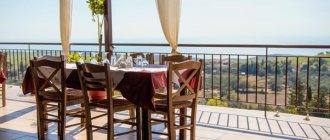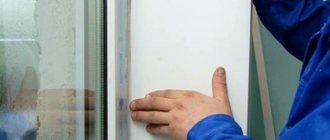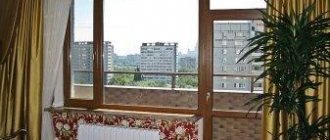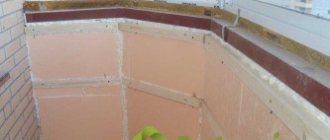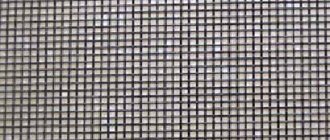Balcony lining is one of the best choices when it comes to balcony repairs.
People often take on the task of renovating their balcony last, since it is not the most used place in the apartment, whatever one may say. However, in the desire to acquire a cozy and beautiful place in their apartment, the owners take up the task of decorating the balcony - the room is sunny, well lit, and you can also admire the view from the window. Having got down to business, apartment owners are faced with the first and most important question - what to cover the walls with. In this case, the simplest solution would be to cover the balcony with clapboard, since the material is not too fancy, easy to use, and repairs of this type do not require large-scale financial costs or effort. Everything can be done quite easily with your own hands, which is what is discussed in today’s article.
Which lining to use
Basically, when they talk about lining, they mean wood products. Much less commonly, PVC panels are also called this term, adding the word “plastic”. Probably, the whole point is in the very similar principle of connecting the planks to each other and the method of their installation, and also in the fact that outwardly it looks like long boards with a tenon on one side and a groove on the other. When choosing which lining to use for a balcony, it is usually based on cost, aesthetic or practical considerations.
Covering a balcony with clapboard is a way to create comfort and at the same time insulate the room
In some regions, wooden lining is a cheap material, in others it is expensive. So you will have to compare the price of plastic and wood yourself. Wood is often preferred because it is natural. This is true, but in order to maintain its attractiveness, it is impregnated with protective compounds, and this is chemistry. Then it is painted or varnished. The compositions, as you understand, are also far from natural.
Based on practical considerations, PVC paneling is clearly ahead: it is easy to clean, does not require additional care or treatment, and retains its unchanged appearance for many years. It might fade on the sunny side, so it’s better to take light colors: the loss of color is almost invisible on them.
Wooden lining is more capricious during operation: before installation it must be coated with protective impregnations. If you are only going to give it some shade, you can choose an impregnation that will immediately give you the desired color. Then this will be the end of its processing. If you decide to paint or varnish the finish, then you need to do this after installation (but still soak it with antiseptics before installation). During operation, you will periodically need to remove the old coating and re-coat everything: the varnish or paint may crack, and the finishing of the balcony will lose its attractiveness. This is such a hassle.
It’s up to you to decide which lining to choose for your balcony.
Despite all this, when deciding which lining is best for a balcony, they give preference to wood. Everyone's tastes are different, of course, but the general consensus is that a room lined with wood is much cozier. As a result, the desire for beauty outweighs practical considerations.
How to cover lining on a balcony so that it remains attractive for a long time, read the article “How to cover lining indoors”
Which is better
We will talk about wooden products. Let's talk about breeds first. The cheapest lining is made of pine and spruce. Despite the relatively low cost, it is durable: coniferous wood contains a large amount of resins, which are antiseptics and preservatives. In regions with hot summers, this can lead to resin being released in places on the sunny side in places of intense heating. Another disadvantage is soft wood. If you hit it (decently, for example with a hammer), a dent will remain. If this doesn’t bother you, you can line the balcony with pine or spruce clapboard: these are all the disadvantages of this type of wood.
Only you can decide which lining is best for a balcony: everyone has different tastes
There are also expensive varieties of conifers: larch and cedar. They have a very dense wood, are more durable, and resist weather conditions well. But these qualities are absolutely not needed for lining the inside of the balcony. A more compelling argument would be the beautiful color and structure of the wood, as well as the lower amount of resin. Cladding with clapboard made of such wood is beautiful and long lasting.
Deciduous wood is pleasing to the eye. Here, choose according to your taste: linden has a slightly pinkish tint, aspen becomes silver-gray, alder has a beautiful pattern, oak in terms of decorativeness and reliability is generally unrivaled, but also in price.
Profiles and appearance
Now about the technical specifications. Let's start with profiles. On sale there is just lining, and there is euro-lining. The main difference is that on the back side of the “euro” version there is one or more longitudinal grooves. They provide air circulation, which extends the “life” of the finish. Also, in theory, lumber with the prefix “euro” has standard sizes and should be produced from high quality wood. In practice, everything is different: the sizes “float” and the quality is not always good.
Most Popular Profiles
There are a couple of dozen profiles. Different chamfers, “waves” of different sizes and other shaped surfaces make it possible to obtain walls with different appearances. The photo above shows the most common ones, usually produced in large quantities.
These are some types that can be made to order
There are several other types that can be made to order. Such a “custom” batch will cost much more: you will have to reconfigure the equipment.
Varieties and humidity
The grade of the lining depends on the number of knots, cracks and discolorations on the board. Grade A or “Elite” should not have them at all, or in very small quantities. Grade “B” - no more than 4 knots of brown color and color changes in a small area; grade “C” can have many knots.
What is the difference between one type of lining and another?
The presence of knots does not mean that the wood is bad. The main thing is that they are brown, not black, and have no signs of destruction. And in general, knotty wood sometimes looks great. All this is a matter of taste and preference.
The situation with humidity is much more serious. Buying lining made from raw wood for interior decoration may be much cheaper, but also much more troublesome. If you nail trim strips with high humidity, it will gradually dry out and shrink in size. Gaps will appear between the boards, some of them will twist or bend. You will have to remove everything, sort it out and reinstall it. Moreover, maybe twice: it is difficult to predict when the shrinkage will end. Therefore, for the interior decoration of the balcony with clapboards, it is better to take chamber-dried lumber. Humidity then is not higher than 7-10%, it will no longer “lead” or bend: these materials were rejected after drying. That's why prices are higher.
About the thickness and width of the planks. For interior decoration, you can use a thin board: the atmospheric conditions are stable. But a balcony is not exactly an indoor space; temperature and humidity changes are more serious. Even with good insulation of the balcony. Therefore, the average thickness is suitable - 14-16 mm, but you can also use 12 mm.
The width and thickness of the houses varies widely
The width of the board can be from 60 mm to 150 mm. It takes longer to nail a narrow one, less work for a wide one, but in a small room, wide stripes “eat up” the volume. So for cladding a balcony, the optimal width of the lining is average, about 90-120 mm.
Spruce and pine - budget species for finishing balconies
Popular conifers - spruce and pine - are the most budget-friendly types of wood that can be used for interior decoration. This is not the best lining for a balcony, but it has a sufficient number of advantages. In addition to the low price, lining made from inexpensive softwood looks interesting and can decorate any room. All wood needs protection from insects, but the aroma that coniferous lining gives off can scare away unwanted guests, even without the use of additional impregnations. The aroma of essential oils is pleasant and beneficial to health, but in regions with too hot climates, this can have a negative effect.
How to cover a balcony with clapboard yourself
First of all, you need to decide whether you will insulate the balcony or not, and if so, which parts of it and with what material. The structure of the lathing and the thickness of the bars used depend on this. The order of work will change slightly - there will be no installation of insulation. All other stages and their sequence will be similar.
Work order - step-by-step instructions
First, all the old finishing is dismantled, plaster, paint, and tiles that do not hold well are removed. Anything that holds firmly can be left untouched. For greater reliability, before covering the balcony with clapboard, it is worth priming the walls, floor and ceiling with an antifungal compound. This is especially true if it was previously open. After the composition has dried, the actual installation work begins:
- Lathing is installed on the walls and ceiling. It is usually made from wooden blocks. If the balcony or loggia is to be insulated, the installation step of the slats is consistent with the width of the insulation.
- The insulation is installed and secured.
- Floor joists are installed.
- Insulation is laid between them.
- Moisture-resistant plywood with a thickness of at least 10-12 cm is laid on top and secured into the joists with self-tapping screws.
- The lining is mounted on the walls.
- The ceiling trim is being installed.
- Floor and ceiling plinths, corners, and slopes are installed.
Below we will talk about some of the stages and materials in more detail.
How to insulate
Before covering the balcony with clapboard, it is necessary to lay insulation. Any of the thermal insulation materials available on the market will do:
- The cheapest is polystyrene foam (PSB). Available in slab form. It has good thermal conductivity (see graph). Its main drawback: it cannot withstand loads - it wrinkles, but under the lining this drawback is unimportant. The second point that many people don’t like is that it is unnatural and can release harmful substances. You can’t argue with unnaturalness, and the second statement is only partly true. Under normal operating conditions, polystyrene foam is chemically neutral and harmless. Releases harmful substances only when burned. Another negative quality: it has low vapor permeability (does not release vapor). But this is the other side of insulation. Today, excess humidity is dealt with using a ventilation system.
You can insulate the balcony under the clapboard with polystyrene foam - Mineral wool. They are made from molten rocks, slag or fiberglass. So this insulation is natural. But in production, phenol-formaldehyde resins are used as a binder, which is not encouraging. There are basalt quilted mats, in the production of which no binders are used - they can even be used in children's institutions. The positive qualities of mineral wool are good thermal insulation properties, ease of work (but not with fiberglass). The disadvantage of this material is its hygroscopicity, which is why it should be closed on all sides from moisture. Price range is average.
Mineral wool has good characteristics, but is afraid of moisture - Extruded (extruded) polystyrene foam (EPS). It has very good thermal insulation characteristics and high density, and resists mechanical stress well. At the same time as thermal insulation, it dampens sounds well. Of the relatively inexpensive insulation materials, it is the most effective. Sold in slabs, it has a locking system, which eliminates the formation of cracks between which cold air can penetrate. This is the material that is most often recommended. If you have the financial opportunity, place it under the clapboard trim. The disadvantages are that they do not conduct steam and are not cheap.
Extruded polystyrene foam has increased density and low thermal conductivity - Foil polyethylene foam. This is an effective vapor barrier that prevents moisture from penetrating into the insulation. When using mineral wool, it needs to be rolled out from above, stapled to the sheathing, and the joints taped with foil tape. You can simply use construction foil, but it is more difficult to work with, and the polyethylene layer is an additional heat insulator. This material alone can be used only in the southern regions; in the rest of the territory it is only an addition that improves thermal insulation.
Foiled polyethylene is nailed over the insulation to reduce heat loss and prevent steam from penetrating into the insulation. - For those who want to have environmentally friendly housing, there is a natural insulation with excellent characteristics: foam glass (foam glass). It does not burn, does not emit anything, light, durable, frost-resistant (operating temperature range from -260°C to +230°C). The thermal conductivity of foam glass is 0.04-0.08 W/(m K). Cut with a hacksaw and mounted on foam. The disadvantage is the high price. There is foam glass from Chinese manufacturers at reasonable prices, but the quality is below average, there is Belarusian glass - average in both price and characteristics, the best is European, but it is expensive.
Foam glass is a natural thermal insulation material with very good characteristics. - Foam blocks are often used to insulate balconies. For normal efficiency, their thickness should be about 27 cm. No one will take such an area from a small-sized room, so a layer of some of the heat-insulating materials described above is still placed on top of the foam concrete.
Comparison of thermal conductivity of various thermal insulation materials.
The required thickness of the material is indicated in centimeters to ensure equal heat loss. Any of these insulation materials can be used on the ceiling, floor or walls. There is a natural and inexpensive option for the floor - expanded clay, but it is not nearly as effective as the materials presented above: the average thermal conductivity is 0.1 W/(m K) (twice higher than that of mineral wool).
Differences between lamellas in profile shape
Eurolining panels have a large tenon, deep grooves and are connected with a tongue lock. A design feature is the presence of shallow grooves designed to drain condensate. The walls “breathe” thanks to the grooves. For the manufacture of lamellas, soft Crimean linden wood is used as the main raw material, which:
- easy to process;
- tolerates temperature changes;
- does not release resins;
- does not swell from dampness.
On the balcony with clapboard made of honey-bearing wood you can smell the garden. White linden boards have an impeccable white hue. The unexpressed graphics of the structural pattern add decorativeness.
- The lining panel imitates laminated veneer lumber with a jagged profile. In addition to external similarity, the segments also repeat the qualitative characteristics of the building material: resistance to cracks and the absence of the slightest deformation. A plastic analogue is also available with an identical locking system.
- “Calm” is best suited for cladding a loggia. Sanded boards have a smooth surface and do not have grooves, which allows you to create a solid canvas.
- “American” is successfully used for external and internal work. It is worth choosing if you intend to decorate with an overlap. For an open loggia, this is one of the best options, since the securely protected joints are not afraid of atmospheric conditions.
- If you choose lining for a balcony from a decorative standpoint, you should pay attention to the semicircular shape of the block house with microspikes and recesses.
Important! Modules made from a natural base will create a special microclimate. Porous wood is able to absorb excess moisture and release it back when the air becomes dry.
How to properly cover a balcony with clapboard
The cladding of a balcony is technologically not much different from the finishing of other rooms: first, the frame is assembled, then the cladding board is nailed to it. It is necessary to align the sheathing horizontally and vertically, and then correctly position the first plank on the wall or ceiling, since all the others are installed from it. Then the second is nailed to the first board, then the third, and so on, until the corner. On the next wall everything repeats again.
Making the sheathing
Cladding with clapboard begins with the creation of a frame - sheathing. It is most often made from a block. The cross-section is selected depending on the thickness of the insulation (if any). The block should be of such a size that there is a gap of 1.5-2 cm above the surface of the insulation. This gap will allow maintaining normal humidity of the insulation and wood, which will prevent the appearance of fungi and mold.
If a beam of the required size is too expensive, you can save money. Under the sheathing take a block of the same thickness as the insulation (or a little more). It is mounted between the guides, and a counter-lattice is placed on top, perpendicularly. It is made from planks 1.5-2 cm thick. They will give the required gap. Just be sure not to get confused with the direction of fastening the lining.
An example of a balcony sheathing under clapboard
Cladding can be vertical or horizontal. The sheathing strips under it are installed perpendicularly. If the trim will be attached vertically, then the sheathing under it should be positioned horizontally.
If there is a counter-batten, the rules change: the primary batten is also packed (vertically), and the counter-batten is packed horizontally. With this system, the planks will be mounted vertically.
More often, clapboard cladding on the balcony is done vertically. Accordingly, installation of the sheathing can begin with the strip under the window block. It is set horizontally, checking the level in two planes. If the wall is uneven, install wooden or plywood pads of the required thickness in the right places. Fasten the sheathing with dowels.
The planks must be installed around the perimeter of the walls and ceiling, 30-40 mm away from the corners. It is also necessary to fill the perimeter of window and door openings. Then the intermediate bars are fixed: one plank from the other should be at a distance of 40-50 cm. It turns out to be a frame on the walls and ceiling, to which the lining is then attached.
A similar structure is assembled on the ceiling
The lining boards are cut slightly shorter than the required length (0.5-1 cm). This is necessary to compensate for dimensional changes due to high temperature and/or humidity.
Installation instructions for lining
They are fastened with self-tapping screws or nails to the sheathing strips. If you use nails, take them with a small head - finishing nails, self-tapping screws - for wood (preferably light ones, not black ones). There is another fastening option - with staples from a construction stapler. This is the fastest way and quite reliable. Just take staples with a long, sharpened leg; T-shaped ones will also work.
The first bar is installed in the most difficult corner to work with. It is placed with a spike in a corner, and the correct installation is checked using a building level. They are nailed into the face (into the front surface), retreating 1-2 cm from the edge. To prevent the wood from splitting, a hole is first made with a thin drill. Then they tighten the screw or hammer in a nail.
On the opposite side (where the groove is located), the lining is secured with nails, screws, and staples. They are driven into the tenon at an angle of 45°. This creates a hidden fastening - it is covered with the next board.
Fastening the lining with a nail (screw, staple) into the groove
There is another option - cladding with clapboard using special mounting plates - clamps. They hold well if the tenon is long enough, and this can most often be observed with eurolining. The clamps are installed in the tenon (as if they are put on it). On the other side they have a mounting plate with holes for nails. One or two nails with a small head are hammered into this plate.
Fastening with clamps
The first board is attached to each plank of the sheathing, all subsequent ones - one after another in a checkerboard pattern (alternating). The second board is inserted into the tenon of the first. If it does not fit tightly, it is tamped down with a small piece of wood placed against the plank. and a hammer. They hit a piece of wood with a hammer. This complexity is necessary to avoid damaging the board. Having driven the tenon into the groove, check whether the bar is vertical. If necessary, adjust, then nail. This is how the entire paneling is assembled. The last plank sometimes needs to be cut to width. It is attached closer to the corner, like the first one, in the face.
The process of installing lathing and wooden lining is shown in the video.
See the video below for the complete process of covering a balcony - from installation of exterior finishing to installation of slopes and trims. We only worked with PVC panels, but the finishing stages are similar. The only difference is that the wooden lining does not have starting strips. All tops and bottoms are covered with baseboards, and corners with corners.
Features of wood
A democratic option for cladding closed loggias on the north side is pine. An abstract pattern on the surface relaxes the attention and creates a pleasant background. A pinkish tint and a unique pattern formed by annual rings, high density, are distinguished by slats made from Scandinavian pine. Features are explained by specific environmental conditions. Siberian and Canadian cedar wood is a recognized antiseptic and heat resonator. Lining made from these bases does not lose these properties. A balcony trimmed with black alder clapboard is more protected from the effects of adverse weather conditions. The main feature of this species is its high hygroscopicity. The material is not subject to cracking and retains its beautiful appearance for a long time. Often combined with eurolining. When choosing a finishing material, you should proceed not only from the design, but also take into account the stated characteristics.
How to process lining
When covering a balcony with clapboards, it is necessary to treat not only the finishing with antiseptics, but also all the sheathing strips. The most popular protective impregnations and primers are listed below. Some of them can immediately give the wood a shade, not by painting, but by emphasizing the texture.
- Senezh Aquadecor is a tinting antiseptic. If you coat wood with this composition, it immediately protects against mold, fungi, and insects, while simultaneously imparting one of 16 shades. No finishing coat is required.
- Aquatex “Grunt antiseptic” is a high-quality protection for lining under subsequent finishing coatings (for example, varnish).
- TIKKURILA VALTTI-POHJUSTE (TIKKURILA VALTTI-POHJUSTE) primer antiseptic for wood, protects against biological damage, but does not protect against ultraviolet radiation. Therefore, prompt staining is recommended.
- Impregnation of the U-409 Estate. It creates a thin polymer film on the wood through which steam penetrates, but this film prevents dirt from penetrating into the wood, preserving the appearance of the finish. The composition includes additives that protect against fungi, mold and insects.
The packaging of each product contains instructions for use and application. It describes the rules of application and consumption to ensure protection. Only by following these rules can you be sure that the lining and the frame underneath will serve for a long time.
If we talk about stains, most modern compositions, while changing the color of wood, also have protective properties. For example, Aquatex stain (analogous to Senezh Aquadecor). It has a wide range of colors and contains a hard-to-wash antiseptic that protects the wood from damage by fungi or insects.
Processing the lining on the balcony can be done in different ways. It is most convenient to use tinting antiseptics for finishing the balcony. A single treatment will immediately protect and add color. But they only add tint, leaving the pores open. Dirt can accumulate in these pores. And cleaning it out is not an easy task. If you also need a protective film that will prevent the penetration of dirt, you can cover the lining (tinted or not) with varnish or dirt-repellent impregnation such as Usadba U-409. Impregnation creates a polymer film on the surface that closes the pores, but does not provide shine.
Problems often arise on the sunny side: how to cover the lining on the balcony so that it does not fade. A light tint that slightly whitens the wood is best. A light wall heats up less and is not afraid of fading. This clapboard cladding looks great.
If you want to have a shiny surface, you can use any varnish for interior work. Watch the video about the types and types of varnishes. It will be easier for you to understand what varnish to coat the lining on the balcony with.
Painting the lining on the balcony with ordinary paint is no longer relevant today. Why spend money on wood and then paint over its texture? Then you can immediately install PVC. So choose: tinting, varnishing, or both.
Material calculation
When planning to cover a balcony with clapboards, it is important to accurately calculate the required number of planks. To do this, it is convenient to use our online calculator to calculate the lining, but if necessary, the calculation can be done manually
Basic data:
- the number and area of sheathed surfaces (only walls, floors, ceilings, additional elements - storage boxes or cabinets, benches, tables, etc.);
- room configuration. This information can be conveniently presented in the form of a detailed drawing with all dimensions;
- profile type and lamella length;
- the number and profile of frame elements (wooden slats or metal parts are used as the frame);
- the need for heat, hydro and vapor barrier, additional ventilation measures;
- auxiliary equipment and furniture. This point takes into account both existing fragments of the situation and planned ones.
The page with an online calculator provides a calculation of the amount of lining for a balcony of standard sizes. Based on the above drawing, we will repeat the calculation taking into account the need to finish the ceiling, shelf and slopes of the balcony block.
For such a balcony, the area of the walls (side walls, walls between the outside room and the room, fences) is 17 sq.m. To this figure you need to add the area of the ceiling and floor:
Total total area is
Taking into account the need to finish the slopes and have a reserve in case of defects, unsuccessful cutting of planks or the emergence of additional ideas, we increase the estimated area by 15%.
If the lining is sold individually, you can purchase it “on a calculated basis; when selling in packages, you will have to purchase such a number of packs that the total area of the lamellas is equal to or exceeds the calculated one.
Preparatory work
Before you start finishing, first of all, you need to think through and plan all the details in advance, starting from visualizing the future interior, measuring the area of the room, choosing the material, and preparing the necessary tools.
Balcony decoration with clapboard photo
When thinking through the design, first of all you should decide what material to use for finishing (natural wood, PVC or MDF panels), what kind of ceiling to simply whitewash or finish with the same lining, whether lighting is needed, if so, in what place. Calculate the area to calculate and purchase the necessary material, if the area of the balcony allows you to additionally make a cabinet and a wardrobe, even plant flowers.
How to choose the right lining with your own hands video
Tools you will need:
- Drill, electric screwdriver and jigsaw with wood saw;
- Tape measure, wood hacksaw, square and pencil;
- Construction level, ax and hammer;
- Nails 30 mm, dowel nails, wood screws 50 mm, 75 mm, 90 mm.
Interesting ideas
Wooden materials look great in any room. The luxury of wood will give the balcony a cozy feel, and natural brown shades will have a calming effect. An original solution would be to cover the floor and walls with panels of different colors.
A more discreet option is the one with skirting boards in contrasting shades. The details will not only hide unevenness and cracks, but will also set off the color of the main coating. You should select elements several tones darker than the lining.
Fans of natural wood can go further and build in furniture in the same shade as the lining. A wooden table and bench will look like a continuation of the walls. In addition, this will save space, since the furniture will be located in the corners.
The main question: do it yourself or hire a contractor?
Owners of apartment buildings begin to repair the balcony when all the rooms have already been renovated. The work is carried out with their own hands or they hire craftsmen. To choose the right solution, it is worth considering several nuances:
- You can finish a balcony with your own hands when you have some experience in such work;
- Doing the finishing yourself will help you save money;
- Hiring a specialist will reduce repair time.
If large finishing activities are planned on the balcony, then it is better to invite professionals. They will do quality work in a short period of time. If the apartment owner is ready to handle the repairs on his own, you can do it yourself, having previously prepared a plan.



